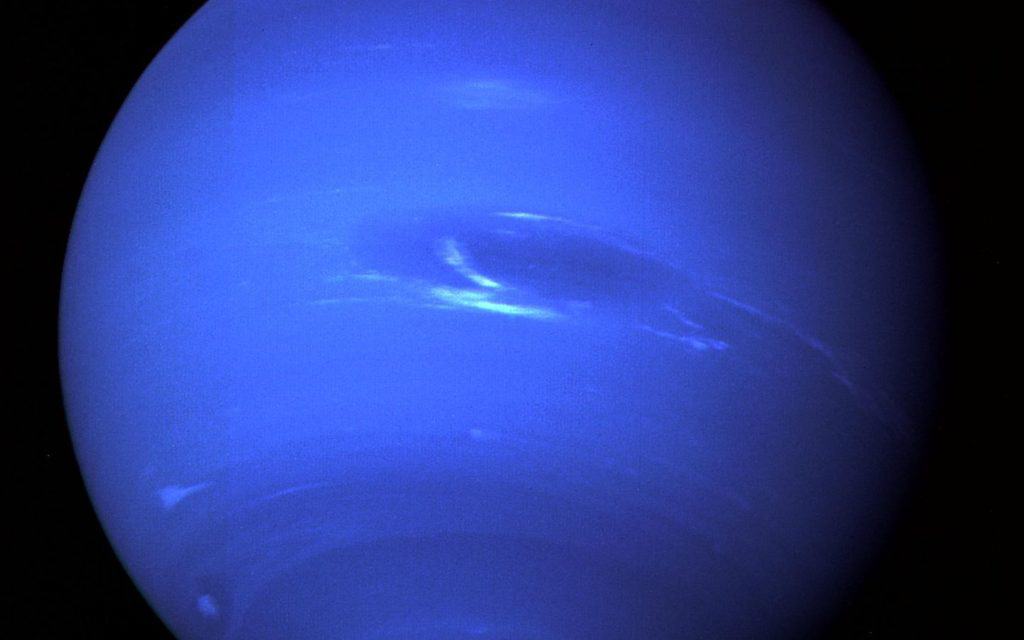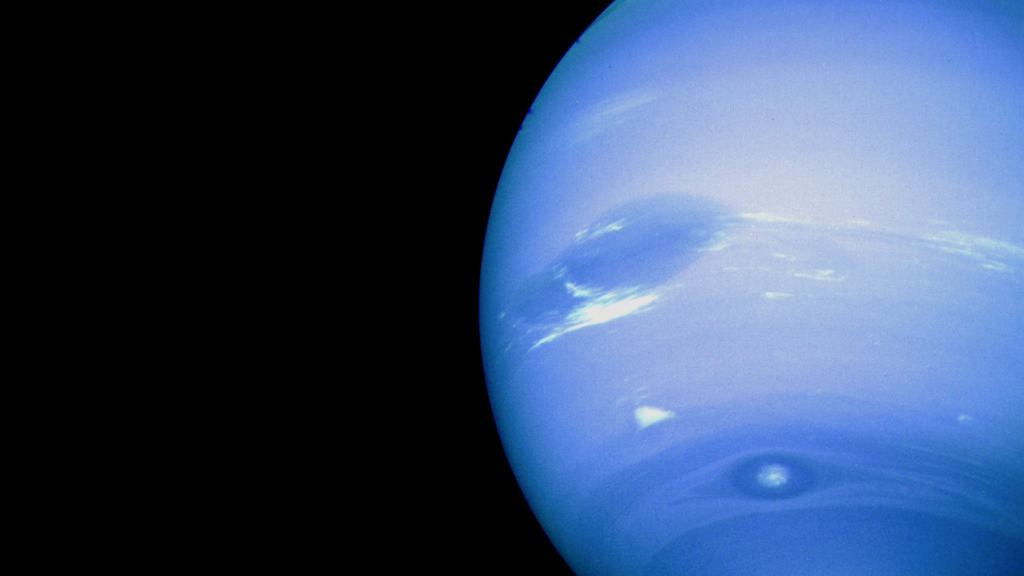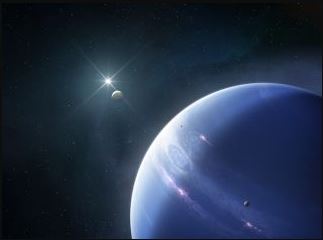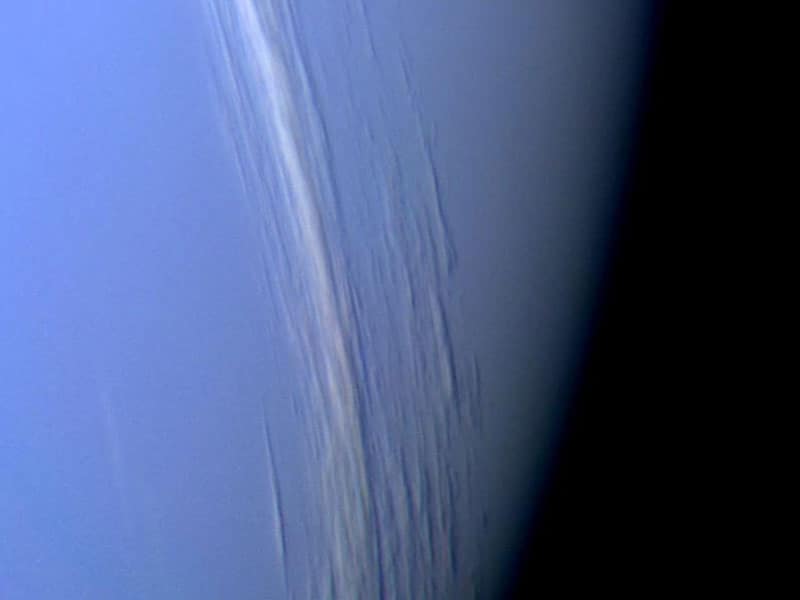The planet Neptune is named after the Roman god of the sea. In Greek mythology, he is known as Poseidon. The planet was probably given this name due to its blue appearance.
Key Facts & Summary
- Neptune is the farthest planet from the Sun at an average distance of 4.5 billion kilometers / 2.8 billion miles.
- Neptune is the fourth-largest planet in the Solar System and the smallest of the gas giants.
- Both Neptune and Uranus are termed ice giants since they have different compositions than Saturn and Jupiter.
- Neptune has a radius of 24.764 km / 15.387 mi, and a diameter of 49.244 km / 30.598 mi.
- The core of Neptune is about 1.5 times the size of Earth.
- Wind speeds on Neptune are among the fastest recorded in the Solar System. Some may reach up to 2.160 km / 1.324 mi per hour. They are five times stronger than the strongest winds on Earth.
- Neptune’s average surface temperatures are around -214 degrees Celsius / -353 degrees Fahrenheit.
- Neptune has a total of 6 ring systems surrounding it. Some of them contain ring arcs or clusters of dust particles.
- Neptune also has 14 moons. The largest moon of Neptune is Triton, and it is the seventh-largest known moon of any planet. Some believe that the moon is actually a captured dwarf planet.
- Neptune’s color is believed to be influenced by the presence of methane in its atmosphere, but there is also an unknown factor contributing to this.
- Neptune is the first planet to be discovered by the use of mathematical calculations and predictions.
- Uranus is Neptune’s near twin in size and composition.
- Neptune has a powerful magnetic field. It is 27 times stronger than Earth’s.
- Neptune formed around 4.5 billion years ago however, many believe that it was closer to the Sun then than now, but the planet started to drift away.
Neptune is the farthest planet from the Sun, and the fourth largest out of all the planets of the Solar System. It is more than 30 times farther from the Sun than Earth.

Though it is far, it is not the coldest planet, that title belongs to Uranus. However, Neptune is very cold, nonetheless. It is a dark and windy planet, having the most powerful winds in the Solar System.
The reason why Neptune is blue is due to the presence of a specific gas named methane. This is also why the planet Uranus is also blue. Both Uranus and Neptune are known as ice giants due to their compositions.
Surface and Structure
The atmosphere of Neptune is made out of hydrogen, helium, and methane. The planet is basically a thick fog of water, ammonia, and methane over an Earth-sized solid center.

Like other gas giants, Neptune has a ring system, six of them to be exact, but they are faint. Neptune also has 14 confirmed moons. The weather on Neptune is very active. Sometimes dark spots form in the atmosphere, which are basically storms the size of Earth.
It has the wildest and strangest weather out of all the planets in the Solar System. The winds speeds on Neptune are the most outstanding.

Some winds have been able to reach up to 2,160 km / 1.324 mi per hour. They are nearly a supersonic flow. These winds break the sound barrier being 5 times stronger than the strongest winds on Earth.
Time on Neptune
A day on Neptune is less than a day on Earth. It lasts for only 16 hours. Since Neptune is the farthest planet from the Sun, it has a very long journey to complete around it. One year on Neptune is equal to 165 Earth years.
Fun Facts
- Neptune was given the name of the Roman god of the sea due to its bluish-ocean like color. All of Neptune’s moons have been named after water deities in response.
- Until the orbit of Pluto was understood, and its status dropped from that of a planet to a dwarf planet, Neptune was considered the second farthest planet from the Sun.
- Neptune was observed in 1613 by Galileo Galilei but he thought that he observed a star and failed to find it again.
- Scientists believe that Neptune formed around 4.5 billion years ago, and it began to drift away from the Sun around 4 billion years ago.
- Light from Neptune reaches us in around 4 hours.
- Deep inside Neptune’s lower regions, there is a hot, dense fluid sometimes called a water-ammonia ocean. Though it is hot, many simply refer to it as icy.
- Some believe that inside Neptune’s lowest regions, conditions are such that even methane decomposes into diamond crystals that rain downwards.
- Neptune has the wildest and strangest weather in the Solar System. However, it is not understood how it gets so much energy to produce such weather.
Size and Comparison
Neptune has a radius of 24.764 km / 15.387 mi, and a diameter of 49.244 km / 30.598 mi. Though it is Uranus’s twin in many ways, it is the smaller of the pair but denser.

Uranus is 103% bigger than Neptune, being only slightly larger with a couple of hundred km/mi. In comparison to gas giants, things get serious.
Saturn has 2.3 times the diameter of Neptune, while Jupiter, the largest planet in the Solar System, has 2.8 times Neptune’s diameter. When it comes to the terrestrial planets, Neptune is four times larger than Earth and Venus. It has 7.2 times the diameter of Mars, and more than 10 times the diameter of Mercury, the smallest planet.
Trivia
Neptune or Uranus?
The name Neptune was first given to the seventh discovered planet of the Solar System. However, the name was discarded but Uranus ultimately led to the discovery of the eighth planet, which would bear the name Neptune.
So maybe in another dimension, this decision wasn’t discarded and Uranus would have been named Neptune, and Neptune would have been named Uranus.
Other names for Neptune
Most languages use some variant of the name “Neptune” for the planet. In Chinese, Vietnamese, Japanese and Korean, the planet’s name was translated as “sea king star” while in Mongolian it is called Dalain Van.
In modern Greek, the planet’s name is Poseidon while in Māori the planet is called Tangaroa, the name of the Māori god of the sea.
The discovery of Neptune
Neptune is invisible to the unaided eye and thus it evaded discovery for centuries, until in 1846 when the works of Le Verrier and Johann Galle found the bluish planet.
Uranus was the greatest factor in the discovery of Neptune. Astronomers were calculating the orbit of Uranus and observed that the planet wasn’t following their models.

This forced astronomers to conclude that another undiscovered planet might be the reason behind the perturbations. Le Verrier predicted where this mysterious planet should be, and Johann Galle found it one degree away from the predicted point. This makes Neptune the first planet ever to be discovered by the use of mathematical calculations and predictions.
Other Characteristics
Neptune is the only planet that isn’t visible to the naked eye. Only with instruments such as telescopes you can see it. Since Neptune is the eighth and most distant planet from the Sun, its only neighbor is Uranus.

The blue planet was discovered in 1846 by Urbain Le Verrier, John Couch Adams, and Johann Galle by the use of mathematical predictions.
One of the largest moons of Neptune is Triton. Triton is even bigger than the dwarf planet Pluto, and some scientists believe that the moon is also a dwarf planet, captured by Neptune’s gravity. Triton is the seventh-largest moon in the Solar System.
Neptune Notes
- Neptune is the eighth planet from the Sun, and the fourth largest.
- It is an ice giant that has the strongest winds of any planet in the Solar System. The presence of methane gives Neptune its bluish color.
- Though Neptune is the farthest planet from the Sun, it isn’t the coldest. The coldest planet is Uranus.
- Neptune has 6 known planetary rings and only 14 confirmed moons. One of them, namely Triton, is believed to be a captured dwarf planet.
- If you stood on Neptune, the Sun would appear 900 times fainter in the sky. If you could fit Earth inside Neptune, you would need 58 Earth’s to do so.
- Voyager 2 is the only spacecraft to have reached Neptune to this day.
- Neptune has no surface since it is basically a swirling world of gases and liquid, surrounding a core. Life wouldn’t be possible to exist there, at least the way we know it.
Sources:
[1.] Wikipedia
[2.] NASA
Image sources:
- https://solarsystem.nasa.gov/system/feature_items/images/82_carousel_neptune_1.jpg
- https://www.jpl.nasa.gov/spaceimages/images/wallpaper/PIA01492-1440x900.jpg
- https://svs.gsfc.nasa.gov/vis/a010000/a011300/a011349/cover-1024.jpg
- https://cdn.mos.cms.futurecdn.net/rCdTVsPesASiv3JeVyhHsa-1200-80.jpg
- https://cdn.mos.cms.futurecdn.net/cLrku7C3dzwjtD4vYBYPvH-320-80.jpg
- https://solarsystem.nasa.gov/system/feature_items/images/86_carousel_neptune_5.jpg
